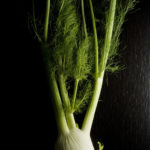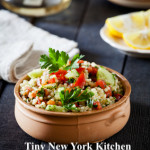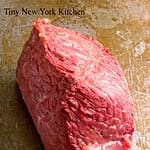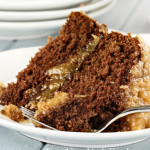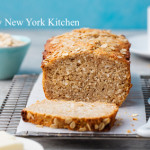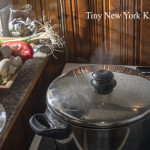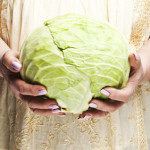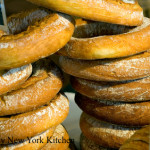Fennel is a member of the carrot family, though it is not a root vegetable. The base of its long stalk weaves together to form a thick and crisp bulb that grows above ground. Fennel’s leaves, seeds, and stems all have a sweet, faintly anise like flavor. The stems of fennel swell and overlap at the base of the plant to form a bulb with white to pale green ribbed layers that are similar to celery in appearance and texture. Light and feathery, the pretty green leaves slightly resemble fresh dill. Use them as a bed for steaming fish or in small amounts as a garnish.
Originating in the Mediterranean, the fennel bulb appears often in Italian and Scandinavian cuisines. It can be eaten raw, grilled, baked, braised, or sautéed. While grilling, you can toss a handful of dried or fresh fennel stems onto the charcoal to infuse meat or fish with a light anise flavor.
When selecting fennel choose fresh bulbs that are smooth and tightly layered with cracks or bruises. Fat, rounded bulbs with white and pale green color will tend to be more succulent than thin or yellow ones. Avoid any with wilted leaves or dried layers. Now available year-round, fennel is at its peak from late fall through winter. Grocers sometimes incorrectly liable fennel as sweet anise.
When storing, keep fennel bulbs in a perforated plastic bag in the refrigerator for up to 5 days. If kept too long, they will lose their flavor and toughen.
When preparing, remove the green stems and leaves, saving them to flavor or garnish other dishes such as soups or fish. Discard the outer layer of the bulb if it is tough and cut away any discolored areas. Cut the bulb in half lengthwise and remove the base of the core as it is thick and solid. Gently separate the layers with your hands and rinse well to remove any grit between them. Slice or cut as your recipe directs.
©Tiny New York Kitchen © 2021 All Rights Reserved
Lucky Foods For New Year’s Day
This New Year’s make a resolution to bring yourself a heaping helping of good luck. It’s as easy as just making dinner.
In cultures around the world, the new year is celebrated with particular foods and recipes thought to bring good fortune. Symbolizing wealth, long life, and prosperity, lucky foods are an auspicious and delicious way to celebrate the holiday and welcome good things in the coming year.
Pork & Sauerkraut
Tender braised pork, along with other forms of pork (like sausages and roasts) is a symbol of abundance in Celtic and Chinese cultures, and is popular amongst the Pennsylvania Dutch on New Year’s Day. Paired with the cabbage in sauerkraut, a Chinese symbol of wealth and prosperity, this easy braise with apples and onions is one tasty pot of good luck.
Black Eyed Peas, Greens & Cornbread
Traditionally eaten in the South on New Year’s Day, this trifecta of ingredients represents three different types of money. Leafy greens represent dollar bills, the round peas symbolize coins and cornbread is the color of gold.
Grapes
According to Spanish lore, eating 12 grapes as the clock chimes midnight on New Year’s Eve will bring you 12 months of good luck. Incorporate this tasty tradition by adding grapes to your holiday cheese board or dessert platter. Or try a delicious side dish with savory sautéed Brussels sprouts, grapes, and crunchy walnuts.
Pomegranates
In Greece, smashing a pomegranate on the floor to release the seeds is a surefire way to bring good luck. The seeds represent abundance and fertility. The more seeds you see, the luckier you’ll be. Instead of smashing, sprinkle that good fortune over peak season oranges, mixed greens, and prosciutto for a colorful celebration of a salad.
Fish
Fish are thought to represent progress and abundance because they constantly swim forward and group together in schools. In Czech culture, the scales of the fish are considered lucky because they resemble silver coins and if you carry a silver coin in your wallet it is said that your money will never run out. Celebrate the new year abundantly with a fish dish that everyone will enjoy.
Noodles
No Chinese New Year, Lunar New Year, celebration is complete without a bowl of noodles. Symbolizing longevity and health, noodles are always left whole. Breaking or cutting a long strand of noodles is considered bad luck. Nourish a long life with a longevity noodles dish.
Cake
Ring shaped cakes, like Bundt cakes, are a sweet way to celebrate coming full circle from the previous year. In cultures around the Mediterranean, a coin is baked into the cake and thought to bring wealth and good fortune to the lucky recipient who finds it. Bake a delicious ring-shaped cake and be sure to warn your guests if you decide to bake it with a coin hidden inside.
©Tiny New York Kitchen © 2020 All Rights Reserved
Tabouli (.تبولة also tabbouleh, tabouleh, tabbouli, taboulah) is a Levantine vegetarian dish made mostly of finely chopped parsley with tomatoes, mint, onions, bulgur (that is soaked not cooked), and seasoned with olive oil, lemon juice, salt, and sweet pepper. Some variations add cucumbers, lettuce, or use semolina instead of bulgur. Tabouli is traditionally served as part of a mezze (small dishes served as appetizers) in the Arab world, but its popularity has grown tremendously in Western cultures.
Originally from the mountains of Lebanon and Syria, tabouli has become one of the most popular salads in the Middle East. The wheat variety salamouni was cultivated in the Beqaa Valley region in Lebanon and was considered, in the mid-19th century) as well-suited for making bulgur, a basic ingredient of tabouli.
In the Middle East, particularly Syria, Lebanon, Palestine, Jordan, Egypt, and Iraq, it is usually served as part of a meze. The Syrian and the Lebanese use more parsley than bulgur wheat in their dish. A Turkish variation of the dish known as kisir and a similar Armenian dish known as eetch use far more bulgur than parsley. Another ancient variant is called terchots. In Cyprus, where the dish was introduced by the Lebanese, it is known as tambouli. In the Dominican Republic, a local version introduced by Syrian and Lebanese immigrants is called Tipile.
“Work With What You Got!”
©Tiny New York Kitchen © 2020 All Rights Reserved
It’s that time of year again, in America, when the beer turns green and the aroma of corned beef and cabbage fills the air. The dish is so comforting, but just what is corned beef? The term has nothing to do with corn, but was the English term for a small granule, such as a grain of salt. In days before modern refrigeration, salting meat was a way to preserve it and keep it from spoiling.
Corned beef is an Americanized addition to the traditional Irish diet. While colcannon (boiled potatoes, cabbage, and leeks in buttermilk flavored with wild garlic) was a common Irish dish, as was brown soda bread, corned beef was produced primarily for export to England. Upon arriving in America, however, it’s thought the Irish chose to celebrate their holiday with food that was typically not available to them in their home country, so corned beef was added to the menu, as was white soda bread studded with currants and caraway.
Corned beef is typically made from beef brisket, which is a cut of meat from the breast or lower chest, but the rump, bottom round, and even tongue, can be used. In America, the term “corned beef” is used to describe both the cured meat and the canned stuff found on grocery store shelves. In Britain, they call the canned stuff “salt beef.”
To make corned beef the meat is simmered in a blend of corned beef spices that usually include peppercorns, garlic, mustard, tarragon, thyme, parsley, cloves, and nutmeg.
In New England, you most often see corned beef served as a St. Patrick’s Day main dish or in a sandwich. As the main ingredient in New England Boiled Dinner, corned beef often pairs with potatoes, carrots, turnips, and cabbage in a hearty, savory, brothy bowl of goodness. When used in a sandwich, the most popular corned beef sandwich is the Reuben. Considered the quintessential Jewish deli sandwich, a Reuben is toasted rye bread stuffed with hot slices of corned beef, usually piled high, and topped with sauerkraut, Swiss cheese, and either Russian or Thousand Island dressing.
In New England, a frequent point of interest is also whether you prefer red vs. gray corned beef. The difference is “Red” brisket is cured with nitrite, which gives the meat its signature color. “Gray” corned beef, which is considered the authentic New England variety, is not cured with nitrate, so color forms naturally as it brines.
If you have corned beef leftovers a New England favorite is corned beef hash, which is typically served for breakfast.
“Work With What You Got!”
©Tiny New York Kitchen © 2018 All Rights Reserved
The average life expectancy for men was 47 years old.
Americans spent 1/3 of their income on food.
Children remained under their parents’ roofs until they were married.
Fuel for cars was only sold in drug stores.
Only 14 percent of the homes had a bathtub.
Only 8 percent of the homes had a telephone.
Ten percent of infants died in their first year.
The maximum speed limit in most cities was 10 mph.
Men wore blue serge suits at work.
The tallest structure in the world was not in the U.S., but was France’s Eiffel Tower.
The average U.S. wage in 1910 was 22 cents per hour.
The average U.S. worker made between $200 and $400 per year.
A competent accountant could expect to earn $2,000 per year.
A dentist could make $2,500 per year.
A veterinarian could make between $1,500 and $4,000 per year.
A mechanical engineer could make about $5,000 per year.
More than 95 percent of all doctors had no college education. Instead, they attended so-called medical schools, many of which were condemned in the press and the government as “substandard.”
Sugar cost 4 cents per pound.
Eggs were 14 cents per dozen.
Coffee was 15 cents per pound.
Most women only washed their hair once a month. They used Borax or egg yolks for shampoo.
Canada passed a law that prohibited poor people from entering into their country for any reason.
The five leading causes of death were: Pneumonia and Influenza, Tuberculosis, Diarrhea, Heart Disease, and Stroke.
The American flag had 45 stars.
The population in Law Vegas, Nevada was only 30.
Crossword puzzles, canned beer and iced tea hadn’t been invented yet.
There was neither a Mother’s Day nor a Father’s Day.
Two out of every 10 adults could not read or write.
Only 6 percent of all Americans had graduated from high school.
Marijuana, heroin and morphine were all available over the counter at local drug stores. Back then pharmacists said, “Heroin clears the complexion, gives buoyancy to the mind, regulates the stomach, bowels, and is, in fact, a guardian of health.”
18 percent of households had at least one full-time servant or domestic help.
There were about 230 reported murders in the ENTIRE United States.
It’s amazing how fast everything has changed and it’s impossible to imagine what it will be like in another 100 years!
“Work With What You Got!”
© Victoria Hart Glavin Tiny New York Kitchen © 2017 All Rights Reserved
German Chocolate is an American creation, created in 1852 when American Samuel German developed a dark baking chocolate for the American Baker’s Chocolate Company. The brand name of the product, “Baker’s German’s Sweet Chocolate,” was named in Samuel German’s honor.
The first published recipe for German’s chocolate cake appeared in a Dallas Morning Star newspaper on June 13, 1957 as the “Recipe of the Day.” Mrs. George Calay, a Texas homemaker, created the recipe. Mrs. Caley’s creation quickly caught on and its recipe, together with the delicious photos, spread all over the country, which is how America fell in love with German Chocolate Cake. The possessive form (German’s) was dropped in subsequent publications, which created the name of German Chocolate Cake that we know today and giving the false impression of German origin.
Thank you Samuel German and Mrs. Caley!
“Work With What You Got!”
© Victoria Hart Glavin Tiny New York Kitchen © 2016 All Rights Reserved
English Stew (1860)
English stew is the name given to the following excellent preparation of cold meat. Cut the meat in slices, pepper, salt, and flour them, and lay them in a dish. Take a few pickles of any kind, or a small quantity of pickled cabbage, and sprinkle over the meat. Then take a tea-cup half full of water; add to it a small quantity of the vinegar belonging to the pickles, a small quantity of catsup, if approved of, and any gravy that may be set for use. Stir all together and pour it over the meat. Set the meat before the fire with a tin behind it, or put it in a Dutch oven, or in the oven of the kitchen range, as may be most convenient, for about half an hour before dinner-time. This is a cheap, simple way of dressing cold meat.
“Work With What You Got!”
© Victoria Hart Glavin Tiny New York Kitchen © 2016 All Rights Reserved
Buttered Cabbage
Civil War deprivations did not stop women from sharing recipes (receipts) with one another. This recipe for Buttered Cabbage was published in Godey’s Lady’s Book in 1862.
“Boil the cabbage with a quantity of onions, then chop them together, season with pepper and salt, and fry them in butter. It is a rather homely, but savory dish, and frequently used either with fried sausages laid over it or as an accompaniment to roast beef, and forms part of bubble and squeak.”
“Work With What You Got!”
© Victoria Hart Glavin Tiny New York Kitchen © 2016 All Rights Reserved
Lucky Foods To Ring In The New Year
Many cultures believe that some foods are lucky and prepare them on New Year’s to ensure good fortune throughout the upcoming year.
Bagels & Doughnuts. Round foods, like bagels and doughnuts, are a great way to start the day and also symbolize coming full circle. As the year is coming to an end, it’s a good reminder that the New Year is about to begin.
Noodles. In China and Japan, long noodles represent longevity, BUT only if you don’t cut or break the noodles. You may want to make some soba noodles in a nice broth for a New Year’s lunch.
Lentils. Lentils resemble coins and plump when you cook them, which symbolizes growing wealth. Pork sausage cooked with lentils (Cotechino Con Lenticchie) Is a traditional New Year’s dish in Italy.
Fish. Whole fish (head to tail) is said to give you good luck from the beginning of the year to the very end of the year. Roasting a whole fish not only keeps it moist, but also adds extra flavor.
Pork. Pigs typically root forward while planting their feet in the ground. This signifies moving forward. In Spain it is traditional to prepare pork chops with grapes. It is customary to eat 12 grapes at the stroke of midnight in order to bring prosperity in each of the coming months.
Corn. The color of gold, which indicates a year of riches. You may want to make a cornbread to go with your New Year’s meal.
Collard Greens & Black Eyed Peas. This is a traditional Southern combination. The greens look like paper money and the black-eyed peas resemble coins. This dish is not only delicious, but also healthy.
Bundt Cake. Like bagels and doughnuts, a round Bundt cake is a delicious reminder that every new beginning comes from some other beginning’s end.
Don’t Be Greedy. While it’s tempting to eat as much of these “lucky” foods that are thought to give you the most prosperous year yet, it’s important not get too greedy. Leaving food on your plate after midnight is associated with a fully stocked pantry in the New Year.
Tiny New York Kitchen Wishes You And Your Family A Very Healthy & Happy New Year!
“Work With What You Got!”
© Victoria Hart Glavin Tiny New York Kitchen © 2015 All Rights Reserved

